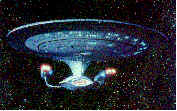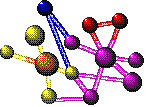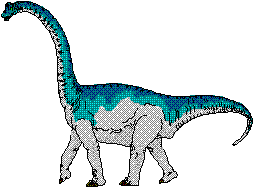 As every good Star Trek fan should
recognize, the above scene occurred during "All Good Things
..." - the Series Finale to Star Trek: The Next
Generation.
As every good Star Trek fan should
recognize, the above scene occurred during "All Good Things
..." - the Series Finale to Star Trek: The Next
Generation.
Books and eBooks by the Director
Sci-Fi and the Primeval Soup
The superbeing "Q" snaps his fingers and transports Captain Picard and himself back 3 1/2 billion years to the primeval earth. As the volcanoes erupt around them on the lifeless planet, Q says to Picard, "Come here; there's something I want to show you."
Q kneels down and points to a pool of dark, thick liquid and declares, "This is you. I'm serious! Right here, life is about to form on this planet for the very first time. A group of amino acids are about to combine to form the first proteins, the building blocks of what you call life."
Dipping his hand into the pool, Q continues, "Strange isn't it? Everything you know, your entire civilization is right here in this little pool of goo."
 As every good Star Trek fan should
recognize, the above scene occurred during "All Good Things
..." - the Series Finale to Star Trek: The Next
Generation.
As every good Star Trek fan should
recognize, the above scene occurred during "All Good Things
..." - the Series Finale to Star Trek: The Next
Generation.
This speech by "Q" provides a simple description of the "primeval soup" theory of the origin of proteins, DNA, and ultimately life popular among evolutionist today. But how sound is this theory? To answer this question requires first a look at the experiments used to support the theory.
Primeval Soup Experiments
In the 1950s, Harold Urey and Stanley Miller, "... thought of imitating in a laboratory experiment the conditions that MIGHT have existed on Earth long ago." In a sterilized, airtight container, methane, hydrogen, and ammonia gases were placed and circulated past a high-energy electrical spark.
"Heat and water vapor were supplied by a container of boiling water connected to the apparatus. As the water vapor circulated, it cooled and condensed as 'rain.' Thus Miller created some of the conditions that MAY have been present in the early atmosphere. Those conditions were the gases, rain, and flashes of lightning."
 After a week,
the original colorless liquid was now red. "When the
substances in the liquid were identified, Miller found that
organic compounds known as amino acids had been formed. This was
an exciting discovery because amino acids are the building blocks
that make up proteins, the most abundant organic compounds in
living cells on Earth. No Earth form of life is possible without
proteins" (Meyer, p.103).
After a week,
the original colorless liquid was now red. "When the
substances in the liquid were identified, Miller found that
organic compounds known as amino acids had been formed. This was
an exciting discovery because amino acids are the building blocks
that make up proteins, the most abundant organic compounds in
living cells on Earth. No Earth form of life is possible without
proteins" (Meyer, p.103).
The above description of the first primeval soup experiment is taken from a college, biology textbook. Many similar experiments have been performed since, with similar results. But do these experiments "prove" life could have arisen by chance?
Be sure to note the words, "might" and "may" that have been emphasized in the description. There is simply no way to know for certain what conditions existed on the earth when it was first formed (supposedly) billions of years ago.
The textbook goes on to state, "Miller's experiment DID NOT PROVE that amino acids were formed in this way under early conditions on earth. But the experiment indicated that a similar process MIGHT have occurred in the early atmosphere of Earth" (Meyer, p.103; second emphasis in original).
But even if amino acids were formed on the early earth, there are still other problems that need to be overcome. As Creation ex-nihilo magazine states, "The gap between an amino acid and the programmed complexity of life is like that between a grain of sand (silicon) and a fully programmed computer" (March-May 1995, p.8).
Formation of Proteins and DNA
Amino acids have been formed in these experiments; but this is a far way from the proteins needed for life actually being created.
First, "Scientist have learned that living things usually make organic compounds of L (left-handed or left-rotating) form, or of D (right-handed) form - but not both.... amino acids made by living things are L" (Meyer, p.116).
The difference between these molecules is one is the mirror image of the other. What is important here is all living things are composed of and can only utilize L-amino acids. Hence why "protein powders" sold in health food stores have amino acid ingredients like L-tryptophan, L-lysine and the like. R-amino acids are never used as they cannot be utilized by humans (or any life form for that matter).
However, in these experiments the "soup" contains equal amounts of both types of amino acids. This kind of mixture of amino acids is called "racemic." And, as science professor L.R. Croft writes, "Most proteins have at least 200 amino acids joined together by peptide bonds to give a single chain" (Croft, p.27).
Moreover, "Proteins made of racemic amino acids (i.e.. L-/D-) would have no activity, in particular, they would have no enzymic activity. And without enzymes there could be no life" (Croft, p.44). So the problem is, if the amino acids in the primeval soup are racemic, how did, by natural forces alone, L-amino acids become incorporated in protein molecules?
In other words, if amino acids had combined by chance to form proteins, an even number of the two types would have been combined and there would have been no life. The odds of only one kind being utilized would be the same as the odds of flipping a coin and it coming up "heads" hundreds of times in a row.
Second, 20 amino acids are seen in proteins and are considered essential for life. And, "A further difficulty is with the type of amino acids formed in the primeval soup experiments. In fact none of the essential amino acids are found in the soup" (Croft, p.44).
These two considerations lead professor Croft to declare, "These experiments have not demonstrated the formation of PROTEIN amino acids at all!" (p.45).
 As regards the
formation of DNA in the primeval soup, it should first be
mentioned that DNA stands for, "Deoxyribonucleic Acid."
A related molecule is RNA, "Ribonucleic Acid." DNA
holds the genetic code for life and RNA is needed for the
replication of DNA. As their names imply, both are types of
nucleic acids and both are necessary for life.
As regards the
formation of DNA in the primeval soup, it should first be
mentioned that DNA stands for, "Deoxyribonucleic Acid."
A related molecule is RNA, "Ribonucleic Acid." DNA
holds the genetic code for life and RNA is needed for the
replication of DNA. As their names imply, both are types of
nucleic acids and both are necessary for life.
In this regard, Croft writes, "Nucleic acids are formed when nucleotides polymerize [combine]; nucleotides are therefore a prerequisite. NUCLEOTIDES, HOWEVER, ARE NOT FORMED UNDER SIMPLE PRIMEVAL SOUP EXPERIMENTS" (p.49; emphasis in original).
So one of the basic building blocks of life are not found in the "soup." And further, "Nucleic acids require proteins for their formation and proteins require nucleic acids - so which came first? One can be certain that they both did not appear simultaneously.... It is a classic chicken and egg predicament" (Croft, p.52).
Croft states further, "And, of more significance, no one has taken a primeval soup experiment and fished out anything resembling an RNA molecule - never mind something that had even the remotest chance of replicating!" (pp.52,53).
Moreover, biologist Michael Pitman points out that DNA and RNA, "... are products of cells and instrumental in making new ones; they do not occur anywhere else.... DNA is exclusively a cell product" (p.146).
So which came first, living cells which produce DNA and RNA or DNA and RNA which are necessary for cell formation and replication? This is again a "classic chicken and egg predicament."
All of these problems, and other which could be discussed, make it highly improbable, if not impossible, that all of the components necessary for life could have originated by natural forces alone on the primeval earth. But even it they somehow were, the biggest obstacle of all would still remain.
But is it Alive?
 The
billionaire in the movie Jurassic Park declared,
"Our scientists have done things which nobody has ever done
before." What they were said to have done was to extract
dinosaur DNA from mosquitoes encased in amber. Missing portions
of this DNA were filled in with amphibian DNA and dinosaurs were
grown. Thus was born "Jurassic Park!"
The
billionaire in the movie Jurassic Park declared,
"Our scientists have done things which nobody has ever done
before." What they were said to have done was to extract
dinosaur DNA from mosquitoes encased in amber. Missing portions
of this DNA were filled in with amphibian DNA and dinosaurs were
grown. Thus was born "Jurassic Park!"
However, this scenario ignored the biggest problem of all: Unless taken from living tissue, DNA IS NOT ALIVE! And, "Turning DNA into living tissue has never been done before." Furthermore, learning how to do so is, "One of the most mind boggling problems in biology today" (from PBS's The Real Jurassic Park, replayed, 5/2/95). And scientist have been trying to solve this "mind boggling problem" for centuries.
Croft writes about scientists in the early 1800's:
They maintained that life could be generated from inanimate matter on the injection of some "vital spark." Charles Darwin believed (as his grandfather before him) that this vital ingredient was electricity. Indeed, Erasmus Darwin was the inspiration for Mary Shelley's Frankenstein (p.10; Note: Shelley's novel was originally published in 1818).
The idea that electricity is the "vital spark" is why Miller circulated liquid in his experiment past an electrical spark. "More recently, other scientists have carried out similar experiments using different energy sources..." (Meyer, p.103).
But, as Winkie Pratney writes, "People have shot long suffering pools of chemicals with everything they can think of - sound, light, heat, gamma-rays, even bullets, but naturally enough, they stay dead."
More fundamentally, Pratney writes further:
We could save a lot of time and trouble and revisit Dr. Frankenstein.... Why bother battering around poor old amino acids when there are all the cells, DNA, enzymes, and proteins you need already assembled in the proper order in your local cemetery (or even the supermarket)? Save the taxpayers millions; hit, burn, shoot sparks into corpses or chicken gizzards. When all is said and done, a lot more is said than is actually done (p.4).
Two Final Points
Much more could be said on this subject. But here, only two final points will be mentioned. First, "One solution to the problem of the origin of life on earth is to propose that it arrived here from somewhere else in the universe" (Croft, p.97). But this idea, "... solves nothing. It simply shifts the problem of the origin of life to another corner of the universe" (Croft, p.102).
And lastly, "Even if the origin of life were a possibility in the laboratories, some intelligent being would have had to produce it. All this is only more evidence that an intelligent all-wise Creator created life" (Sippert, p.214). As the Bible teaches:
"All things
came into being through [Christ],
and without Him not even one thing came into being
that has come into being.
In Him was life, and the life was the light of men"
(John 1:3,4; MKJV).
Bibliography: Note: Unless otherwise indicated, all
emphases in quotes are added.
Creation ex nihilo. Creation Science Ministries PO Box
6330 Florence, KY 41022-9937.
Croft, L.R. How Life Began. Durham, England: Evangelical
Press, 1988.
Meyer, Don. et.al. Biological Science: A Molecular Approach.
Lexington, MA: D.C. Heath & Company, 1985.
Pitman, Michael. Adam and Evolution. London: Rider &
Company, 1984.
Pratney, Winkie. "Creation or Evolution?" Part I.
Lindale, TX: Last Days Ministries, 1981.
Sippert, Albert. From Eternity to Eternity. N. Mankato,
MN: Sippert Publishing Company, 1989.
Books and eBooks by Gary F. Zeolla, the Director of Darkness to Light
Sci-Fi and the Primeval Soup. Copyright © 1999 by Gary F. Zeolla of Darkness to Light ministry (www.zeolla.org/christian).
The above article originally appeared in Darkness to Light
newsletter in 1995.
It was posted on this Web site in July 1996.
![]() Text Search
Text Search ![]() Alphabetical List of
Pages
Alphabetical List of
Pages ![]() Subject Index
Subject Index
![]() General Information on Articles
General Information on Articles
![]() Contact Information
Contact Information
Darkness
to Light Home Page
www.zeolla.org/christian